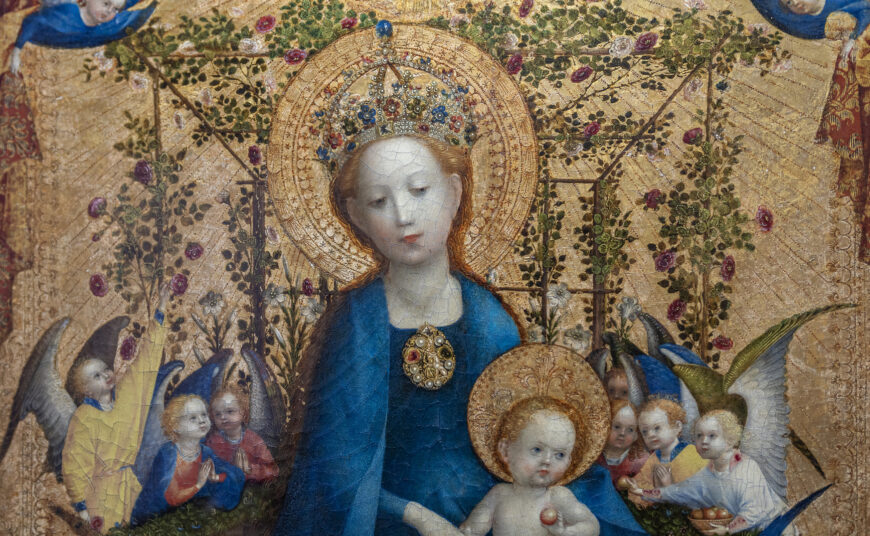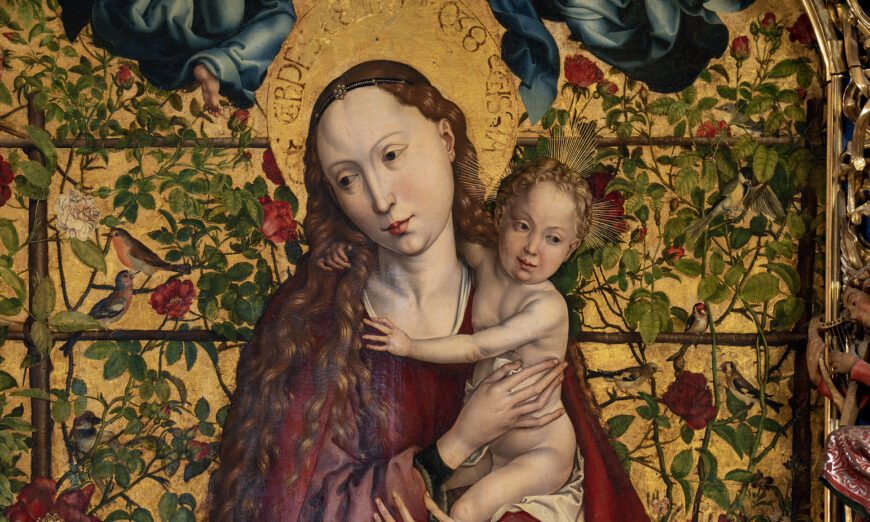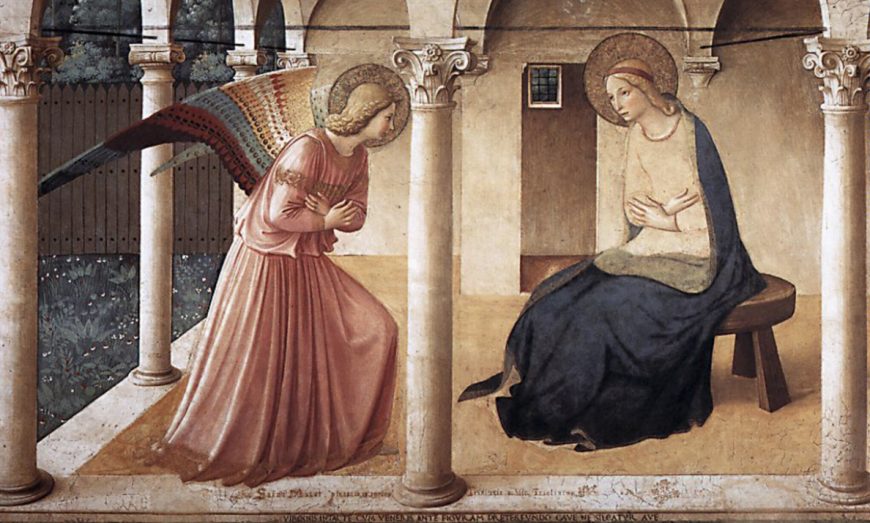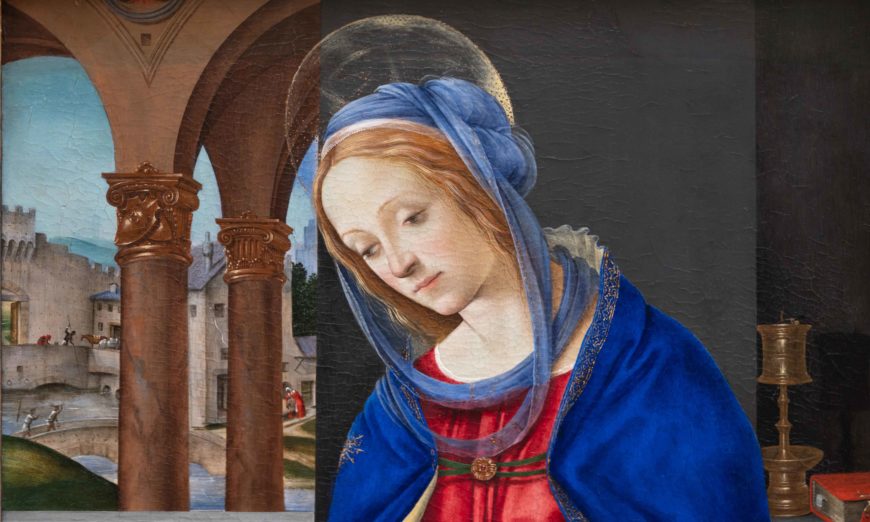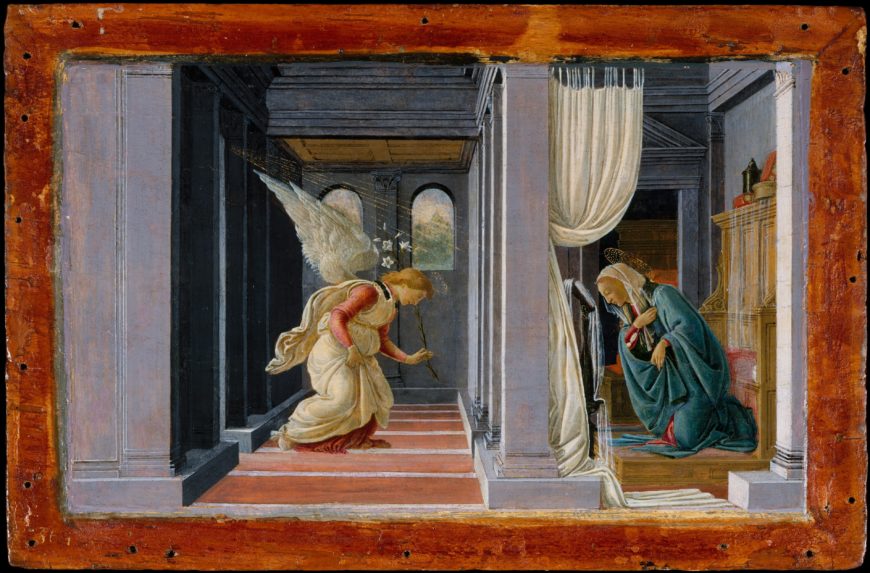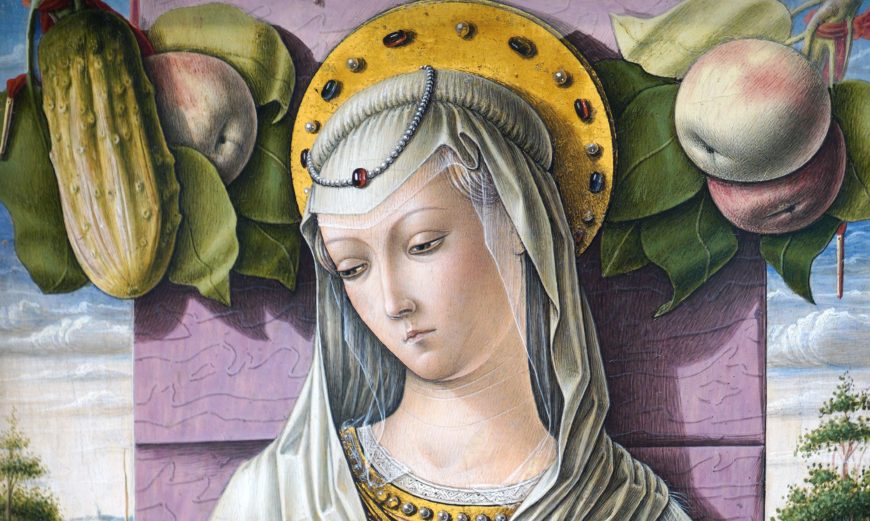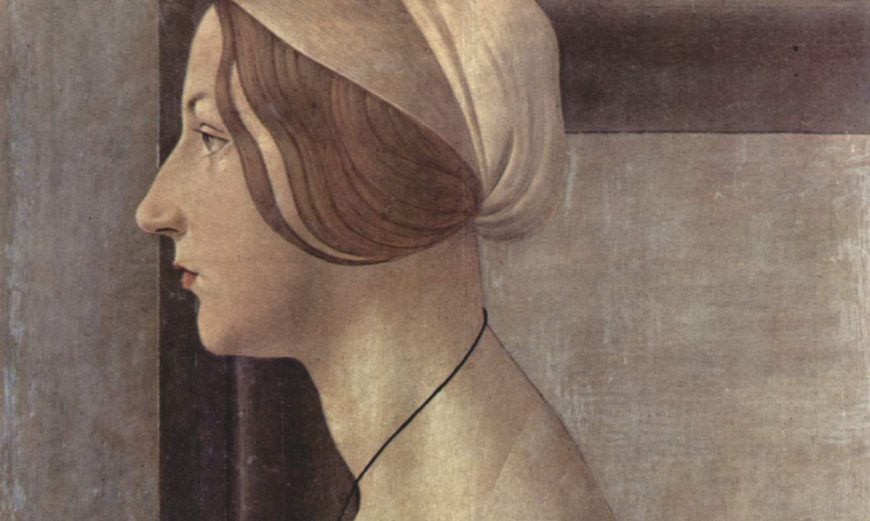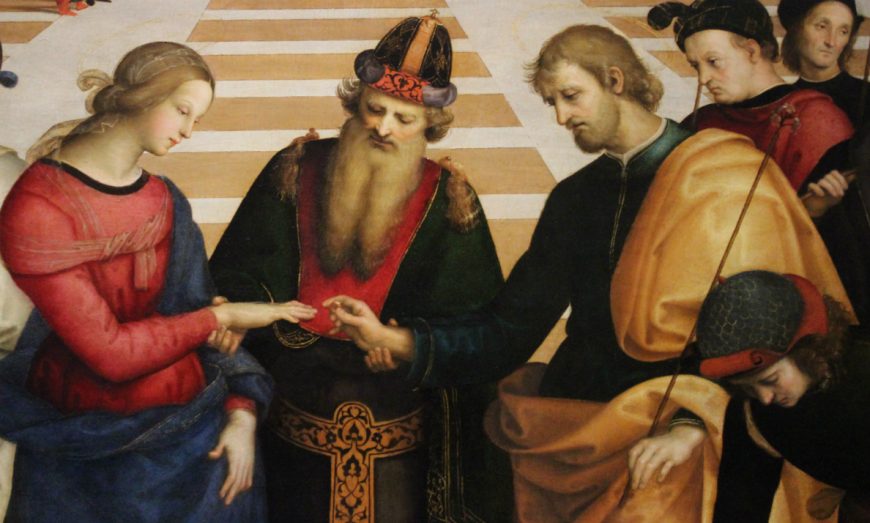Gentile da Fabriano, Adoration of the Magi, 1423, tempera on panel, 283 x 300 cm (Galleria degli Uffizi, Florence)
[0:00] [music]
Dr. Steven Zucker: [0:03] One of the wealthiest people in early Renaissance Florence commissioned Gentile da Fabriano to paint a magnificent altarpiece for his family’s private chapel in an important church, Santa Trinita.
Dr. Beth Harris: [0:17] The subject is the Adoration of the Magi. The Magi are, by legend, the three kings who follow a star that leads them to Christ, who’s just been born, to whom they present gifts and acknowledge Christ as king of kings by removing their own crowns and placing them before Christ.
[0:35] This was commissioned by a man who was incredibly wealthy, essentially the king of Florence, but Florence had no kings. Florence was a republic.
Dr. Zucker: [0:44] The city of Florence was an independent political entity that was controlled by the wealthy merchants of the city and the guilds.
Dr. Harris: [0:51] The people of Florence were independent and proud members of a republic. Then you had this enormous accumulation of wealth, especially in the early 15th century.
Dr. Zucker: [1:02] This painting is a perfect way of showing off that wealth. The artist came from northern Italy, settled in Florence in large part because there was money to be made there. There were patrons to be had there.
Dr. Harris: [1:13] He was very handsomely paid for this altarpiece. We read one estimate that he was paid six times the annual wage of a skilled laborer for this one altarpiece.
Dr. Zucker: [1:23] His particular style is one of opulence. It’s a bejeweled surface. There’s gold. It’s a perfect way for one of the leading families in Florence to show its importance.
Dr. Harris: [1:34] The Strozzi family made their money primarily through banking, through handling gold. Although Palla Strozzi, the patron for this particular painting, ignored the banking business and was much more interested in the arts and humanist learning.
Dr. Zucker: [1:47] As we stand here in the Uffizi Museum in Florence, it’s interesting to watch people look at this painting because people are picking out the many anecdotes that you can recognize, very much the way people would have when the painting was first made. This is a real crowd-pleaser.
Dr. Harris: [2:01] Well, there’s fun things to see.
Dr. Zucker: [2:03] We can make out the story of the Magi very clearly. It’s really quite an inventive structure because you have a continuous landscape. What we’re seeing within it are a whole series of moments in time.
Dr. Harris: [2:14] It’s a continuous narrative.
Dr. Zucker: [2:16] In the upper left corner we can see the three kings, very distant, just under the star of Bethlehem over the sea. We understand this from the story to be in the East.
Dr. Harris: [2:25] Which explains their attire. Then in the central arch, we see the three kings entering Jerusalem, where King Herod asked the three Magi to report back where they find this king that King Herod has heard will threaten his reign.
Dr. Zucker: [2:39] He would like to kill the child, but of course doesn’t let on. Then in the rightmost upper corner, we see the three Magi entering the city of Bethlehem. Then presumably the scene that is laid out before us is taking place there.
Dr. Harris: [2:52] We get the sense of a crowd watching the three Magi approach Christ and Mary.
Dr. Zucker: [2:58] The Christ child is playful. Look at those feet. We see the three Magi in the process of bowing down before Christ. You can see that there are two attendants just behind Mary that are examining the first gift and Joseph is standing to Mary’s left.
Dr. Harris: [3:13] The spurs are being removed from the youngest Magi’s ankles. He’s just gotten off his horse and he’s about to approach Jesus.
Dr. Zucker: [3:21] In fact, we see lots of pages. There is a sense of the courtliness of this scene. The spurs that we were talking about are really marvelous. They’re actually built up to be three-dimensional, and this is done with plaster that is then gilded, but what it makes it look like is that it’s a solid piece of gold, that this is jewelry attached to the image itself.
Dr. Harris: [3:40] You can see why that treatment of the gold might appeal to as wealthy a patron as Palla Strozzi.
Dr. Zucker: [3:47] Now, the style of this painting is generally referred to as International Gothic. This is the last moment of the Gothic before the Renaissance will develop.
Dr. Harris: [3:56] And that’s because we don’t see some of the things that we associate with the early Renaissance here. Unlike with Masaccio, who’s painting just a few years after this, we don’t see linear perspective. In fact, we see a building up of the figures pressed into the foreground.
Dr. Zucker: [4:11] The artist is avoiding the overlapping and obscuring of figures.
Dr. Harris: [4:15] At the same time, we see foreshortening, which helps to create an illusion of space with the horse on the right, for example, or the horse behind, who’s facing us.
Dr. Zucker: [4:25] And of course diminishing scale. The figures get smaller as we’re meant to read them going further back in space. The artist may have been influenced by somebody like Ambrogio Lorenzetti, who had created an extensive landscape in the city of Siena.
Dr. Harris: [4:37] The figures are still somewhat elongated, especially if you look at the Virgin Mary. Although the artist is using modeling to describe her knees and her thighs, if she were to stand up, I think we would see her as being tall and thin.
Dr. Zucker: [4:51] I think the emphasis here is on her elegance, her beauty, as opposed to her anatomical accuracy.
Dr. Harris: [4:56] Which would be a very Gothic thing and not a very Renaissance thing.
Dr. Zucker: [5:00] The main panel is set between smaller scenes. Above, we have Christ blessing, and then we have an Annunciation on either side. Then below, we have three predella scenes.
Dr. Harris: [5:10] In the predella panels, we see three scenes from Christ’s childhood. On the left, the Nativity. In the center, the Flight into Egypt, and on the right, the Presentation in the Temple.
Dr. Zucker: [5:21] Let’s take a close look at the Nativity.
Dr. Harris: [5:23] This has been called one of the first night scenes in art history, lighting that comes from the moon and the stars and the angels and the Christ child himself.
Dr. Zucker: [5:31] There are so many lovely details. Look, for instance, at the crown of peacocks worn by the figure on the right, or the way in which the flowers in the frame push outward.
Dr. Harris: [5:43] To me, this painting is very much an accumulation of details. There’s a lot to look at, but it still resides in the late medieval Gothic tradition.
Dr. Zucker: [5:52] It’s a reminder of the tremendous wealth that would make the Florentine Renaissance possible.
[5:58] [music]

Gentile da Fabriano, Adoration of the Magi, 1423, tempera on panel, 283 x 300 cm (Uffizi Gallery, Florence)
When looking at Gentile da Fabriano’s Adoration of the Magi, imagine yourself in front of it. Not standing in front of the painting in the bright Uffizi gallery, but in front of an altar in a dark sacristy, watching flickering candlelight dance on layers of silver, gold and paint that have been molded, incised, and glazed into glittering textures. The effect would be overwhelming. Only after this visual shock would you begin to look more closely, wondering what the painting is actually about, who could have painted such a thing, and—perhaps just as importantly for the Renaissance viewer—who could have possibly afforded it. The answers to these questions are complex and intertwined. Yet, with a little historical context, they can be found in the painting itself.

The three magi presenting gifts to the Christ child (detail), Gentile da Fabriano, Adoration of the Magi, 1423, tempera on panel, 283 x 300 cm (Uffizi Gallery, Florence)
An altarpiece fit for kings
The altarpiece depicts several Gospel stories surrounding the birth of Christ as they were retold in the Middle Ages and Renaissance. In the main panel, three Magi (wise men and kings believed to come from unknown, eastern lands) offer gifts to the newly born Christ child. Their adventure begins in the background: smaller scenes of the Magi fill an extraordinary landscape in the three arches above, allowing us to follow their journey in a cartoon-like, continuous narrative.

The magi entering Jerusalem (detail), Gentile da Fabriano, Adoration of the Magi, 1423, tempera on panel, 283 x 300 cm (Uffizi Gallery, Florence)

Magi (detail), Gentile da Fabriano, Adoration of the Magi, 1423, tempera on panel, 283 x 300 cm (Uffizi Gallery, Florence
At far left, they climb a mountain in search of the star they believed would fulfill an ancient prophecy telling of a great king. Following this star, the magi lead their impressive retinue to Jerusalem, shown at the top center of the painting (see image above), and then to the smaller town of Bethlehem at the upper right corner.
The main action of the panel then unfolds in the foreground, where the Magi finally arrive at the small cave where Joseph and Mary have been forced to take shelter with their newborn child. Haloed and resplendent, each king takes his turn offering a gift of gold, frankincense, or myrrh, removing his crown, and kissing the foot of the tiny baby.
As in earlier images of the Magi, they are accompanied by large numbers of courtiers and attendants on horseback as if they were emissaries from a foreign country. More than previous artists, Gentile used the journey of the Magi as an opportunity to flaunt his visual imagination and technical skill. The ‘kings’ do not wear ancient clothing, as one might expect from a biblical story, but imaginative costumes designed to look luxurious and vaguely exotic. The royal retinue is bursting with varied figure types, intricately patterned brocades, and rare animals. Foreground figures are almost stacked on top of one another, as if the ground is tilted forward in order to fill a limited space with a maximum number of figures. Such decorative opulence is continued in the ornate, three-arched frame.

Right foreground (detail), Gentile da Fabriano, Adoration of the Magi, 1423, tempera on panel, 283 x 300 cm (Uffizi Gallery, Florence)
The altarpiece is not just visually busy, but also rich with narrative detail. The dog in the right foreground looks up in fear toward a horse that is about to carelessly step on him. At far left, two female attendants curiously (and somewhat rudely) inspect the precious gift the elderly king has already presented to the holy family.
Even the background includes stories-within-stories. Look for a lonely traveler being accosted by thieves, or for a leopard preparing to pounce toward a local deer he has just spotted from his seat on the back of a horse. These anecdotal, even humorous incidents invite the viewer to inspect each area of the painting carefully, discovering something new at each turn.
From Fabriano to Florence
This was the sort of visual abundance at which Gentile da Fabriano excelled. The artist’s impressive skills were nurtured during his travels to artistic centers throughout Italy. As his name suggests, Gentile was from the town of Fabriano, over a hundred miles southeast of Florence. Years spent in the northern towns of Venice and Brescia in particular encouraged his love of courtly ornamentation and an interest in the close observation of plants and animals. These sojourns also helped build his reputation, and his arrival in Florence by 1422 at the height of his powers would have caused quite the tizzy among the city’s artists and the elite families who patronized them.

Lorenzo Monaco, Madonna Enthroned (from a ten-part altarpiece), 1390-1400, 61 x 123.7 cm (The Toledo Museum of Art)
At the time, Florence was awash with creativity—a crucible of varying artistic styles. In the works of Lorenzo Monaco, the most successful Florentine painter in these years, an infusion of curving, northern European forms enlivened the inherited tradition of the previous century.
New directions were being pioneered in the practice of sculpture and architecture: Brunelleschi had just conducted his now famous experiment in perspective and the sculptor Donatello helped to revive a taste for classicizing figures and illusionistic depictions of space. The young Masaccio was a scant few years away from changing the history of art by exploring these innovations through the medium of painting.
Palla Strozzi
Into this moment of visual experimentation and change stepped Gentile da Fabriano, a virtual artistic celebrity throughout Italy and beyond. He soon received a prime opportunity to demonstrate his abilities to the city: a prestigious commission from Florence’s wealthiest citizen, Palla Strozzi. Strozzi spent an unprecedented sum on the building and decoration of his family’s chapel in the sacristy of the church of Santa Trinità. Sometime before 1423, the banker turned to Gentile for an altarpiece as part of this project. The Adoration of the Magi represents the result of this commission, showing us that Gentile knew just how to dazzle an expectant audience.

The patron, Palla Strozzi (detail), Gentile da Fabriano, Adoration of the Magi, 1423, tempera on panel, 283 x 300 cm (Uffizi Gallery, Florence)
Although we are not sure why a scene of the Adoration was chosen for the painting, it seems likely that Palla saw the subject as an opportunity to display his status in other ways.
The courtly retinue of Gentile’s painting reminded viewers of Palla’s diplomatic credentials: the banker had travelled as a member of official Florentine visits to various cities throughout Italy. He even had himself depicted as one the Magi’s courtiers. Just behind the third king, he stands holding a falcon—a reference to his family, since strozzieri was the Tuscan word for “falconer” (left).
Other personalized symbols are cleverly included in the painting. The bridle on the white horse to the far right, for example, is decorated with a crescent moon, the central feature on the Strozzi coat-of-arms.

Right edge with frame (detail), Gentile da Fabriano, Adoration of the Magi, 1423, tempera on panel, 283 x 300 cm (Uffizi Gallery, Florence)

Two attendants, the Madonna and Christ Child and St. Joseph (detail), Gentile da Fabriano, Adoration of the Magi, 1423, tempera on panel, 283 x 300 cm (Uffizi Gallery, Florence)
A different kind of naturalism
Gentile’s altarpiece visually announced the amount of gold his patron could purchase and the caliber of artist he could afford to hire. But it also displayed Palla’s cultivated taste for the new and daring. For all of its apparent preoccupation with wealth and worldly status, the Adoration celebrated nature in a way that few paintings had before. People, animals and their movements are carefully observed. Flowers seem to burst forth from the pillars that bracket the frame (see detail above). The subtle modeling of figures’ faces is quite different from the stark contours seen in paintings by popular Florentine artists such as Lorenzo Monaco. And Florentine viewers would surely have noted how fur and fabric were depicted using softer brush strokes than those they were used to seeing. More remarkably, the scenes within this complex structure create a sort of visual dissertation on different kinds of light and shadow. In the main scene, the famous star of Bethlehem illuminates surrounding trees, gilding the edges of their leaves and casting intricate shadows behind the heads of the maids at left.
The small panels below the main scene (a supporting structure known as a predella) are even more experimental in their depiction of different kinds of lighting. The Nativity (image below) is imagined as a night scene with multiple sources of light: the supernatural radiance emanating from the small Christ Child, the brightness of the angel appearing to shepherds in the background, and the much softer glow of the moon at top left.

Nativity (predella), Gentile da Fabriano, Adoration of the Magi, 1423, tempera on panel, 283 x 300 cm (Uffizi Gallery, Florence)
In the middle predella panel, the new family flees to Egypt against a landscape bathed in the blazing midday sun – a raised golden orb amid a blue sky showering the nearest hillsides in gold. The last panel shows Christ’s presentation in the temple, the building’s dark interior warmly lit by a wall lamp at its center.

The Flight into Egypt (predella), Gentile da Fabriano, Adoration of the Magi, 1423, tempera on panel, 283 x 300 cm (Uffizi Gallery, Florence)
Gentile used real gold to achieve many of these subtle lighting effects, demonstrating his ability to combine intricate manipulation of precious materials with an interest in naturalism. Perfecting a technique that would be copied by many other artists, he layered gold leaf underneath layers of paint to lend brightly lit surfaces an added glow—an effect that would be more readily apparent in candlelight. This means precious metals are woven underneath the surface, on the surface, and protruding from the surface, like a tapestry made of paint and gold.
Looking again
To the modern viewer, Gentile’s Adoration may seem too busy, too ornate and too crowded. Even art historians have sometimes had difficulties looking past its emphasis on patterning and flattened space to see how this painting and other works by Gentile contributed to the flowering of the arts in Early Renaissance Florence. Yet the altarpiece’s very richness helped to insure its influence, allowing artists to draw different lessons from Gentile’s painting techniques and visual interests. These contemporary viewers likely understood what present-day visitors to the Uffizi might forget: that the Adoration was not designed to be taken in at a single glance. If we remember this and try to look at the image the way it was meant to be looked at—again and again—it will reward each viewing.



